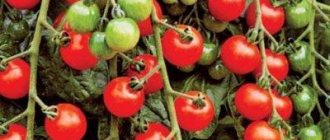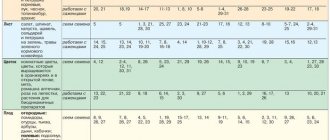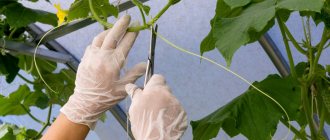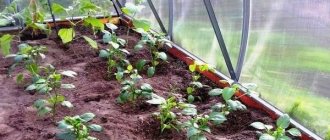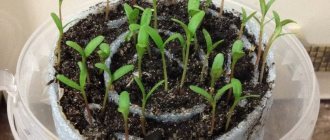The tomato is a perennial evergreen tropical plant native to South and Central America. In our country, it is cultivated as an annual crop. Popular varieties ↓
- for open ground: Alpatieva 905, White filling, F1 Verlioka, Grotto, Malyshok, Moskvich, F1 Portland;
- for greenhouses strong> - F1 Bolero, Bull's Heart, F1 Vasilyevna, F1 Gamayun, De Barao, F1 Centaur, F1 Mithridates, Oksana, F1 Olya, F1 Russian size, F1 Northern Express, F1 Favorite, F1 Funtik;
- cherry-shaped - F1 Bead, F1 Winter cherry, Sweet million
Characteristics of culture
At a young age, the stem of tomatoes is herbaceous and erect; later it becomes woody. On the nature of branching of shoots and the duration of growth of the main shoot
There are several types of bush:
- indeterminate (branching, their growth is unlimited, usually one brush is laid 3 leaves from the other)
- determinate (weakly branched, the growth of the main shoot ends in an inflorescence)
A variety of determinate varieties are standard varieties with a thick, non-lodging stem and shortened internodes.
Starting from a young age, tomato plants form side shoots in the axils of the leaves - stepsons. Indeterminate varieties form stepsons from the axils of all leaves, which takes away the plant’s strength to set and ripen fruits, so they require pinching (removal of side shoots). Determinate varieties produce shoots from the axils of the lower leaves. They can produce a crop, so determinate varieties, as a rule, do not need pinching.
The tomato inflorescence is a raceme that can be short or long, loose or compact. In early varieties, the first flower cluster is formed above the 5-7th leaf, and in later varieties - above the 10-14th leaf, approximately 30-40 days after emergence. Flowering begins 40-90 days after emergence; 45-65 days pass from flowering to ripening.
Fertilization of the flower occurs at an air temperature of 24-32 degrees. Lower or higher temperatures result in delayed fruit set.
The shape of tomato fruits can be flat-round, round, plum-shaped, pear-shaped, cylindrical; by color - lemon, orange, pink, crimson, green, red, purple. When ripe, the fruits change color from milky (light green with a whitish tint) to brown or blazing (brown with a light pink tint), and finally to the color characteristic of the variety.
Based on size and weight, fruits are classified into:
- very small - less than 20 g.
- small - 21-50 g.
- average - 51-100 g.
- large - 101-200 g.
- very large (beef tomatoes) - more than 200 g.
When to pick tomatoes for ripening
For ripening, fruits are removed at the stage of milky or blanzhesky ripeness. It can be identified by the greenish or white tint of the tomato skin. Blanche tomatoes quickly ripen at home and acquire a bright, rich taste and color characteristic of a particular variety.
How to determine if a tomato is ready to ripen:
- the size of the tomatoes corresponds to those characteristic of a particular variety;
- When you cut a tomato, you can see fully ripened seeds;
- green tomato skin with a whitish tint;
- tomato pulp is pink in color.
For home ripening, damaged and bruised tomatoes, as well as fruits with traces of rotting, fungal diseases and insect pests, are not used. Such tomatoes cannot be left on the bushes; they must be immediately removed from the garden to prevent infection of healthy bushes.
Selection of varieties and hybrids
More than 1,100 varieties and hybrids of tomato are included in the State Register of Breeding Achievements; in addition, many unregistered varieties are sold in garden centers. It is difficult for an amateur vegetable grower to navigate this sea of commercial offers.
One of the main parameters by which you need to select a variety or hybrid for cultivation is its early maturity (the period from full germination to the first harvest of fruits).
Tomatoes are:
- ultra early ripening - 80-85 days
- early ripening - 85-110 days
- mid-season - 110-120 days
- late ripening - 120 days or more.
According to their purpose, there are varieties and hybrids of tomato
- salad
- for whole-fruit canning
- for long-term storage for 2-5 months
- carpal (they are removed with brushes)
Depending on how many seed chambers there are inside the fruit in a cross section, varieties and hybrids are divided into small-chambered (2-3 chambers) and multi-chambered (6-10).
In Russia, about 25% of tomatoes are grown in open ground, 60-70% in protected ground, so a number of varieties and hybrids are designed specifically for open ground (these are mainly early ripening varieties and hybrids), while others are intended for protected ground (they, as a rule, taller).
The popularity of old varieties, zoned back in the 40-70s. XX century, can be explained by several reasons. These varieties are highly cold-resistant and resistant to stress, diseases and pests. They are productive (4-5 plants can be placed per 1 m2), the fruits are dense, suitable for canning and fresh consumption, they are early ripening (fruits ripen on the 85-90th day from germination) and have time to form fruits before being affected by late blight, their can be grown in the northern regions of Russia.
Old varieties are intended for cultivation in open ground and do not require shaping, like varieties and hybrids for protected ground. Another advantage of old domestic varieties is that they are varieties, and not hybrids, therefore, seeds can be collected from plants that will retain the properties of the variety and will not cause splitting of characteristics.
In addition, the cost of seeds of tomato varieties is significantly lower than the cost of modern new domestic and foreign first-generation hybrids (F1).
Ripening time
Of course, in closed ground, plants form fruits faster, and their ripening period is much shorter than when growing tomatoes outdoors. How long it takes from germination to fruiting depends on the variety or hybrid. Growing hybrid plants is considered the most profitable from an economic point of view in conditions of short and cool summers.
Hybrid seeds are designated by the manufacturer on the packaging as F1. Experienced vegetable growers already have their own preferences in varieties and hybrids. It is not easy for summer residents who are beginning to grow tomatoes to understand the huge assortment of seeds, and in the pursuit of a large harvest, mistakes are sometimes made that affect the number of formed and ripened fruits.
There are several unpretentious varieties and hybrids that novice vegetable growers are especially successful in growing. Such tomatoes are not only advantageous for their early ripening, but also form a friendly and large harvest of high-quality marketable fruits. These varieties and hybrids include tomato seeds “Typhoon”, “Semko”, “Verilioka” and “Druzhok”.
To obtain a very early harvest and minimize the time spent on ripening, it is recommended to plant the varieties
“Uragan”, “Samara”, “Yantarny” and “Junior”.
It is very important to remember that the earliest ripening is typical for varieties belonging to the determinate type. However, the indeterminate type of tomatoes produces a more abundant harvest. If it is necessary to grow an unpretentious, abundantly fruiting and early-ripening plant, preference should be given to modern zoned hybrids. Knowing how long the growing season takes, it is quite easy to determine the timing of planting such tomatoes.
Growing tomato seedlings
Tomato is a light-loving and heat-loving crop, demanding on growing conditions. The brighter and more intense the light, the faster the harvest is formed. Prolonged cloudy weather extends the ripening period of fruits by 10-15 days and worsens their taste.
Optimal temperature for plant growth and development: 22-24 °C during the day, 16-18 °C at night. At temperatures below 10 °C, plant growth stops, pollen does not ripen, and the ovaries fall off.
In our climate, a tomato harvest can only be obtained if seedlings are planted in spring greenhouses or open ground at the age of 40-65 days. If the greenhouse is heated, then tall, late varieties of tomatoes are sown as seedlings in mid-February, and early-ripening low-growing ones, some of which will be planted in open ground, in the first ten days of March.
About a month before sowing, the fullest seeds are selected, soaked in a pink solution of potassium permanganate for 20 minutes, washed, wrapped in a slightly damp linen napkin, then in a plastic bag and placed on the top shelf of the refrigerator door.
2-3 days before sowing, the seeds are dipped directly into water in a napkin, lightly squeezed and placed in a warm place. It is important to ensure that the napkin does not dry out.
Without a good soil substrate it is impossible to obtain full-fledged seedlings. If the soil is of high quality, then a minimum amount of fertilizing will be needed, the plants will be strong, with short internodes and a branched root system.
Individual containers measuring 9x9x9 cm or a common sowing box are filled in advance with soil substrate (for 1 bucket of leaf soil - a half-liter jar of wood ash, a three-liter bag of peat and half a bucket of garden soil).
On the eve of sowing, the soil is lightly compacted and watered abundantly. Tomatoes are sown according to variety, containers are placed in pallets and covered with film. The seeds are sprinkled with loose soil, then the tray with containers is placed in a large plastic bag and placed in a warm place.
As soon as the shoots appear, the containers are transferred to a well-lit, cool windowsill and the bag is opened slightly. It is very convenient to use labels; they can indicate the variety, sowing date and time of emergence.
When sowing in boxes, make grooves 8-10 mm deep at a distance of 4-5 cm from each other, seeds are sown in them at a distance of 8-10 mm from one another, covered with a 10-15 mm layer of moistened soil mixture, and covered with film or glass.
Smaller planting leads to the removal of the seed coat at the ends of the folded cotyledon leaves, which injures the plants. The hard shell must be moistened several times a day with warm water from a pipette, and then carefully removed or wait for the plant to shed it itself.
The optimal temperature for seedling growth in the first two weeks is 20-22 °C (without sharp fluctuations at night), then 18-20 °C. In cloudy weather, additional lighting is turned on above the seedlings; on warm days, the room must be ventilated, but without drafts. Excess moisture is removed from the pan and the soil is mulched.
With the appearance of the second true leaf, seedlings are picked from boxes into individual containers and buried down to the cotyledon leaves. 25-30 days after this, the grown seedlings are transferred to large containers (12x12x15 cm).
It is possible to obtain good seedlings only if the seedlings are provided with a sufficiently large area of nutrition: the leaves of neighboring plants should not touch.
Approximately 10 days after transplantation, the first feeding is carried out with an extract from wood ash, after 2-3 days - with an infusion of onion peels (a liter jar is filled with peels, poured boiling water and left for 3-4 hours, then filtered and diluted with water in a ratio of 1:5).
This infusion contains many trace elements, but its secret has not been fully revealed. But the effect is amazing: the tomatoes literally become sturdier before our eyes with thick stems and large dark leaves.
Very soon the first flower cluster emerges. This serves as a signal to plant seedlings in a greenhouse or open ground under light cover.
Tips for storing tomatoes
In addition to the generally required conditions that prolong the life of fruits, there are a number of tricks, the use of which simplifies the storage of tomatoes:
- To protect against rotting processes, it is advisable to cover the tomatoes with Vaseline or paraffin. These substances gently envelop the surface of the tomato and prevent the proliferation of pathogenic bacteria inside it, serving as reliable protection;
On average, tomatoes coated with Vaseline are stored and preserved better.
Storing tomatoes in several layers without protection in the form of straw or sawdust is very limited in time
Tomatoes can crack both during ripening and subsequent improper storage.
A controversial point during storage is the removal of the stalks. Some gardeners unanimously say that removal is necessary, otherwise the stalk will take some of the juices for itself, worsening the condition of the berry. At the same time, by removing the stalk, we make the berry more vulnerable to various infections. It is impossible to give unambiguous advice in this situation, because each gardener is guided by his own individual experience.
Planting seedlings in a greenhouse
Planting in solar-heated greenhouses, frames and film tunnels in the Non-Black Earth Region is carried out from mid-May, in the south a month earlier. To speed up the heating of the soil, ash, peat chips, and crushed coal are scattered on the snow.
The soil in the greenhouse is loosened, filled with humus (a bucket per 1 m2) and wood ash. The top spent layer is replaced in the fall, after harvesting. The prepared soil is watered with a solution of a biological product to activate the work of soil bacteria.
Mark the places for planting seedlings and sow compacting crops: lettuce, spinach.
The tomato responds well to proximity to basil, leeks, stalked celery, parsley and marigolds.
Film covering of unheated greenhouses saves plants from temperatures not lower than -2 ° C; at lower temperatures, additional shelter is required. Taking this into account, seedlings are planted when the threat of spring frosts has passed and the soil has warmed up to 14-16 °C.
The tomato is placed with row spacing of 70 cm or in a strip method (the distance between strips is 90 cm, between rows in a strip is 50 cm). Leave 35-40 cm between plants in a row. Trellis wire is pulled over the rows. It is better to plant plants on a cloudy day, and in sunny weather - in the evening.
The hole is made in such a size that the entire root ball and 3-5 cm of the stem can freely fit into it. Before planting, seedlings and planting holes are watered generously with warm water. Place 3-4 handfuls of loose humus in each hole.
The seedlings are buried down to the first leaves, the soil is pressed down and watered from a watering can through a strainer. It is necessary to ensure that the roots do not bend upward along the stem.
Then all the “bare” soil in the greenhouse is mulched first with a layer of humus, then with mown grass, which always contains dandelion and nettle leaves. After a week, the plants are tied to the trellises under the first or second leaves so that during the process of growth and thickening of the stem the twine does not cut into it.
Tomato planting and flower pollination
During the flowering period, tomatoes should also be pinched to make it easier for the bushes to form correctly. In addition, such actions contribute to the development of large fruits in greater quantities. At the same time, pinching eliminates the risk of developing late blight.
The pinching procedure involves getting rid of plants from side leaves and shoots. During the flowering period, it is necessary to carry out the second stepsoning.
Pollination by bees also has a beneficial effect on fruit development.
Unfortunately, these conditions do not exist in the greenhouse, which is why some actions must be performed. In warm sunny weather, it is recommended to shake the tomato flower clusters a little. But be sure to do this as carefully as possible. In order for the pollen on the pistil to germinate faster, after the pollination procedure the plants should be sprayed with water, specifically the flowers and only with a fine spray, and the soil can simply be watered.
After 2-3 hours, to reduce the humidity in the room, you need to open the window and door. It is very important to ventilate the greenhouse, because it has a beneficial effect on the flowering stage of tomatoes. However, condensation should not form on the film.
Overmoistening the soil helps reduce the level of sugar and dry matter in fruits. This can result in sour and watery tomatoes, which, for example, is often characteristic of market tomatoes. Proper watering of tomatoes in a greenhouse results in a high and high-quality harvest.
05.02.2018
Hello, dear readers! Any experienced or novice summer gardener passionately desires to get a rich harvest of tomatoes, which, in addition, will also have an exquisite taste and beautiful shape. But not everyone understands how meticulous the work from planting a seed in the ground to the fruiting of an adult plant can be.
There are many nuances to cultivating tomatoes. Entire books are written on this topic, where secrets are revealed and various methods for breeding healthy specimens are discussed in depth. But, as they say, “you can’t know the peak without studying the base,” so every gardener should first learn the basics, and only then succumb to the general boom in breeding rare varieties.
In this article we will look at how long tomatoes grow, how long a tomato needs in each phase of its growth to form into a full-fledged, generously fruiting bush.
Caring for tomatoes in a greenhouse
Seedlings planted in the ground are watered for the first time immediately after planting, and the second time after 5-6 days. Subsequently, watering is carried out every 7-10 days at the rate of first 1.5 liters, and then 1.6-2 liters per plant. Inexperienced gardeners water plants more often, but in small doses.
This is not recommended, since it is important that the root system develops as deeply as possible, and with frequent watering it forms in the surface layer of soil.
Soil moisture must be maintained constant, since an uneven supply of moisture leads to cracking of the fruit.
Indeterminate tomato varieties usually form one stem (if planted sparsely, two), determinate varieties - 2-3 stems. The second and third stems are obtained from stepsons growing in the leaf axils under the first inflorescence. The strongest shoots of tomatoes always develop in the axils of the leaves located directly under the inflorescence.
Polyethylene film transmits ultraviolet and heat rays well, which contribute to the rapid growth of plants. The moisture permeability of such a shelter is low, high humidity is created under it, so good ventilation must be organized in the greenhouse.
The most serious difficulty in growing nightshade crops is May frosts. Vegetable growers know that tomatoes tolerate severe short-term frosts more easily than weak, but long-term frosts. Frequent sprinkling can prevent the death of a tomato, even when the bush is covered with an ice crust. As soon as the sun comes out, the ice melts and the plants take on their normal appearance. Watering is carried out with cold water before sunrise.
The effectiveness of sprinkling is based on the fact that during morning frosts, plants suffer not so much from freezing, but from subsequent burns, which occur from a rapid change in temperature with sunrise. Watering helps the plant gradually thaw.
Further care for tomatoes in the greenhouse consists of regulating the temperature, watering, weekly addition of mulch from mown grass, fertilizing, and removing shoots. Tomatoes are planted when the shoots are no more than 3-5 cm. At the end of July, the growing points are pinched and ripe fruits are regularly collected.
In thickened plantings, the top of the stem (when grown in one stem) is pinched above the 3-4th cluster to get the earliest harvest. In indeterminate varieties, pinching is done over the 8-10th brush. In any case, 1-2 leaves are left above the flower cluster, which promotes good ripening of the fruit.
Pollination will be more intense if you create a draft in the greenhouse or shake the plants by hitting the support wire. Spraying flowers and buds at the beginning of flowering with approved growth regulators improves fruit set.
Experienced vegetable growers advise “feeding” plants in unheated greenhouses with a nutrient solution heated to 25 °C. This helps to increase the yield of the early harvest by 10-12%, and the harvest from the first three fruit clusters of plants - up to 200 g. 8-10 fertilizing can ensure a good harvest.
The first is carried out after the seedlings have taken root: for 10 liters of water take 15 g of ammonium nitrate, 50 g of superphosphate, 10 g of potassium chloride. Subsequently, before the start of fruiting, the doses are reduced: 10 g of ammonium nitrate, 25 g of superphosphate and 15 g of potassium chloride are dissolved in 10 liters of water. During the fruiting period, the amount of nitrogen doubles. If the soil is old, less fertilizing is required, if new, more fertilizing is required.
Tomatoes especially need phosphorus. If the seedlings were deficient in this element at an early age, then the leaves, first on the lower side and then on the upper side, acquire a purple tint.
Phosphorus makes the bushes strong, resistant to diseases and temperature changes. When planting seedlings in a hole, be sure to pour 15-20 g of superphosphate into it.
Tomato plants urgently need potassium fertilizers: when there is enough of this element, the fruits turn out to be sugary, beautifully colored, and shelf-stable.
There is no need to get carried away with nitrogen when growing tomatoes. Its excess leads to excessive development of the vegetative mass of the plant, numerous stepsons, and delayed fruit ripening. Phosphorus-potassium fertilizers help eliminate this problem: on a moderate nitrogen background, they contribute to smoother ripening of fruits.
Supporters of organic farming fertilize once every two weeks with mullein infusion, wood ash extract and green fertilizer. The latter is prepared mainly from nettles, quinoa and legumes. The barrel is filled 2/3 with grass, 500 g of onion peels are added, the finished infusion is filtered and used not only for watering at the root, but also for spraying on the leaves.
To prevent fungal diseases, use nettle infusion (500 g of herb per 10 liters of water). It is sprayed on tomato plants 3-4 times in June and July.
By fruit color
Many gardeners try to grow tomatoes in greenhouses in all the colors that breeders have invented. The salad looks great with yellow, red, pink and black tomatoes.
Pink
There are more and more lovers of pink tomatoes for greenhouses among gardeners.
Pink honey is a medium-ripe variety that grows to a height of only 1 meter, but is densely overgrown with pink, sweet, fleshy fruits weighing up to 1 kg. The fruits are so large that you can make a salad from one tomato. The variety produces high yields; up to 6-7 kg are harvested from 1 bush. The fruits are slightly ribbed and heart-shaped. Among the pink varieties, they are the sweetest.
Dad . When choosing sweet varieties of tomatoes for greenhouses, pay attention to the early-ripening, high-yielding variety Batyanya. The weight of one fruit can reach 700 grams. 9 kg of tomatoes are harvested from 1 bush. The sweetish fruits have juicy, fleshy pulp, without white veins. The peel is thick crimson, glossy. Everyone who imprisons Batyanya has never regretted it.
Reds
There are a lot of red varieties; gardeners distinguish:
- Azores Red Bride . The bushes grow up to 2 meters. Large, fleshy fruits up to 800 grams ripen on them.
- Scarlet flower is a high-yielding variety. The fruit color is red or pinkish. The pulp is juicy, tasty, sweet, sugary. The weight of one tomato can reach 700 grams. Resistant to diseases.
- Altai honey is a mid-season variety that reaches a height of 1.7 meters. Up to 6 kilograms of tomatoes are harvested from one plant. The fruits are heart-shaped, weighing up to 350-600 grams. The peel is red-pink, the flesh is fleshy, sugary with a honey flavor.
Yellow and orange
Orange and yellow tomatoes for the greenhouse are a real find. They are very tender and tasty, for example:
- Variety Midas . This is the earliest variety. Already 45 days after planting the seedlings, you can pick the first orange fruit. It can be stored for more than a month without losing its beautiful appearance.
- Orange Heart is a mid-season variety that can grow above 2 meters in height. 6-10 kg of tomatoes weighing up to 300 grams are harvested from the bush. The pulp has a small number of seeds, fleshy, sour-sweet, with a slight fruity flavor. Tomatoes can last until November.
- Citrus garden - yellow tomatoes, shaped like lemons, which is why they got this name. Sweet, tasty, just begging to be put into your mouth.
Black and purple varieties
Exotic lovers will definitely grow varieties of black tomatoes for the greenhouse. In addition to their exotic appearance, black tomatoes are rich in anthocyanins.
Black or purple fruits are known to improve the functioning of the cardiovascular system, reduce the risk of stroke, and are very beneficial for men's health. They are also useful for older people, as they improve memory.
Among the black varieties, the most favorite are:
- Dagestan,
- Evening,
- My favorit,
- Chocolate,
- Black Russian.
Purple tomatoes are also useful for the greenhouse:
- blue tomato,
- Blueberry,
- Lilac Lake,
- Chernomor.
Growing tomatoes in open ground
Only low-growing, early-ripening varieties of tomatoes are planted in open ground. For them, you can set aside a bed adjacent to the south side of the greenhouse. Since autumn, it has been seasoned with humus, dolomite flour and wood ash. In early spring, a row of beans can be planted on three open sides of the ridge, which will initially protect the tomatoes from the wind and bright rays of the sun.
Prepare planting holes, fill them with humus and wood ash, and spread plastic film. The next day, water the tomato seedlings generously and plant them in the prepared holes, deepening them down to the first leaves. The soil must be mulched with humus, chopped nettle and dandelion leaves.
If the weather is cold at the beginning of June, arcs are installed over the tomatoes and non-woven material is stretched; when it warms up, it is removed. A thick layer of mulch from humus and mowed grass in the root zone makes the soil loose and moist, but during drought, watering is carried out with warm water.
Once every two weeks, feed the tomatoes with mullein infusion, green or mineral fertilizer. Before the onset of cold August nights, you can have time to pick the fruits from “street” tomatoes.
If the weather is cold at the beginning of June, arcs are installed over the tomatoes and non-woven material is stretched; when it warms up, it is removed. A thick layer of mulch from humus and mowed grass in the root zone makes the soil loose and moist, but during drought, watering is carried out with warm water. Once every two weeks, feed the tomatoes with mullein infusion, green or mineral fertilizer. Before the onset of cold August nights, you can have time to pick the fruits from “street” tomatoes.
In August, tomatoes are watered only in the mornings, no more than once every 10 days. In cool, damp weather, watering is not needed at all; it is better to loosen the soil once again and fill it with rotted sawdust or unripe compost.
If the days are cool, then the top of the mulched bed is additionally covered with black non-woven material or film. This will allow the soil to warm up better, because mulch is an excellent heat insulator. In addition, spores of pathogenic fungi remaining in the soil will not be able to get out.
If tomatoes are grown every year in a permanent place, then after harvesting the mulch must be removed and sent under the currant bushes.
The top layer of soil (approximately 10-15 cm) can be transferred to a compost pit or flower bed. Then pour one bucket of humus, a liter jar of wood ash, a half-liter jar of dolomite and bone meal onto 1 m2 of soil, mix everything well and loosen it. For the winter, the bed must be mulched with a thick layer of humus.
Harvest time
It is possible to increase the quantity and significantly improve the quality of fruits only with strict adherence to harvesting rules. The regularity of collection is of no small importance. Harvesting can be carried out at the stage of partial ripening or full ripening of tomatoes. In the first case, it may be necessary to ripen the fruits, but already at the stage of milky ripeness, tomatoes are edible and can be used for preparing soup dressing, salads and canning.
In closed ground, harvesting takes longer. When growing plants outdoors, the last fruits should be harvested before the end of August, and in cold and rainy summers, the harvest time is reduced to the second ten days of August.
Harvesting and storage
Fruits must be collected in dry weather, picking them off the stalk and placing them in rows in boxes lined with paper.
Ripe red tomato fruits can be stored at a temperature of 1-2 °C for about a month, pink and brown ones at a temperature of 4-5 °C - up to 2 months.
The optimal temperature for storing green fruits is 12-21 °C, for hard pink and red ones 8-10 °C at an air humidity of 85-90%. Late-ripening varieties and hybrids are best stored.
During the ripening process of tomato fruits at a temperature of 20-25 ° C and a relative humidity of 80-90%, pink fruits will turn red after 2-3 days, white ones - after 4-6 days, green ones - after 7-10 days. It has long been noticed that if you put red and brown fruits together with green ones in a dark room, the green ones will take on a red color.
Before frost, you can not remove individual fruits, but pull out the plants by the roots and hang them upside down for ripening.
Features of tomato harvesting
Greenhouse heating plays a significant role in harvesting. If the gardener has the ability to control the temperature in a given room, then there are no obstacles to the year-round harvesting of ripening fruits.
The presence of a built-in heating system allows the gardener not to depend on the weather when harvesting
If your greenhouse is not equipped with heating and depends on the weather outside, then you should focus on the following tips:
Tomatoes on branches ideal for sale
If tomatoes take a long time to ripen, the gardener can increase the flow of nutrients to the berries
Video - Details of tomato harvesting in a greenhouse
Diseases and pests
The tomato is affected by late blight, blossom end rot, brown spot, gray rot, and is damaged by aphids, mites, thrips, whiteflies, and Colorado potato beetles.
Constant fight against diseases and spraying with all kinds of drugs increases the resistance of pathogenic fungi and bacteria to poisons. And chemicals that were effective last year may not work this time.
But many diseases develop rapidly, literally “burning” plants in a matter of days. Late blight, which affects nightshade crops, is characterized by such aggressiveness. When the first signs of the disease appear, it is already useless to treat the plants, unless, of course, you spray them with powerful drugs. But a tiny amount of poison remains in the fruit even after the waiting period.
So the main focus should be on disease prevention. A mandatory measure is to treat the seeds and disinfect the soil with a one percent solution of potassium permanganate.
Foliar feeding is carried out only in the morning, and the foliage is also sprayed once every 10 days in the morning with biological products that suppress the development of pathogenic fungi. These drugs can also be used during the fruiting period, since the longest waiting period is 3 days.
3-4 days after the first signs of late blight appear, the plants remain without green leaves
Copper preparations inhibit the germination of late blight spores, but they can only be used 20 days before harvesting the fruits. Instead, it is best to use traditional methods - infusions of wormwood and tansy, spraying the foliage with them once every 10 days. The substances contained in these herbs prevent the germination of late blight pathogen spores.
The working solution is prepared as follows: half fill a bucket with chopped fresh grass and leave for a day. Next, soap is added to keep the liquid on the leaves and the plants are sprayed. Garlic also has a fungicidal effect; for 10 liters of water you will need 1.5 cups of garlic minced in a meat grinder. You can also add a little potassium permanganate there.
If symptoms of the disease appear, you must urgently remove all the fruits, including unripe ones, and disinfect them for 1-2 minutes, immersing them in hot (60 ° C) water. Then, after drying, the tomatoes are placed for ripening in a warm room with a temperature of about 25 ° C.
By the way, gardeners often mistake cold burns of fruits, which form already at a temperature of 3-5 °C, for late blight. This crop spoils quickly. With late blight, the fruit first hardens and begins to rot only when it is almost completely affected.
How to water tomatoes for faster ripening
- Potassium humate must be watered once every ten days.
- During the flowering period, the plant must be sprayed with a 0.5% superphosphate extract.
- Half a month before harvesting, the formed fruits are sprayed once with a growth stimulant called Hydrel.
- The bush is fed with boric acid after watering if the plant begins to lose flowers or ovaries.
- Spraying with iodine (6 drops per 2 liters of water). The fruits, leaves and stem are sprayed.
Frozen tomato bushes
Closer to October, frosts come to the Urals. Until this moment, you need to collect all the tomatoes that remain on the plants.
These photographs were taken on October 2, 2022. Tomatoes in an unheated polycarbonate greenhouse, frozen at -10 degrees outside. It was about -8 degrees in the greenhouse.
After such freezing, all that remains is to cut the bushes and put them in compost. If the plants were sick, remove them as far from your site as possible. Burn if possible.
The tomato growing season can be considered closed.
Signs of maturity
Any vegetable grower knows that tomatoes need to be collected or picked at the stage of incomplete ripeness. A properly harvested crop in a greenhouse guarantees the production of high-quality tomatoes, which can be used not only for ripening, but also for full processing. Tomatoes must be harvested while respecting the ripening time, and the first tomatoes in the greenhouse are picked at the stage of full ripeness.
The main signs of ripeness that allow for timely harvesting depend on the variety of tomato and the method of growing it. The timing of determining when it is possible to harvest fully ripe tomatoes in a greenhouse varies greatly. The climatic conditions of Russia require the planting of early ripening varieties, which can be harvested as early as possible.
Growth phases
Different stages of tomato development require different care. During the adaptation period - the first 10 days after planting, you should not carry out any procedures with tomatoes, it is not even recommended to water them. They must get used to new conditions, and if they are disturbed, young plants may weaken and become sick.
It is best to plant tomatoes in the third week after transplantation and form no more than two trunks, unless your tomatoes are cherry varieties. When a month has passed, the tomatoes are tied up, since even lying on the ground for a short time can lead to fungal diseases or attack by pests from the soil.
If all the minimum measures for the favorable development of the plant are observed, then approximately forty days after planting the seedlings in the ground, the tomato will begin to bear fruit, and another 20 days after the ovary, the tomato fruits will begin to turn red.
Full maturation before wilting of a tomato as a plant will occur approximately on the 90th day if your tomatoes are of an early ripening variety and on the 110th day if they are of a regular variety. In general, the entire life of a tomato from sowing to full ripening lasts a maximum of 140 days.
But these are the plants that we are used to growing on the ground, and if we talk about home or indoor tomatoes, then by choosing the right variety, this plant will grow for up to five years and constantly delight you with its harvest.
With the “Rich Harvest” virtual simulator, growing tomatoes is much faster, and you won’t mind throwing an unsuccessful harvest in the trash, because you can’t eat it anyway. But you will be able to see your mistakes in order to prevent them in the future and grow excellent vegetables.
Tomatoes grown in a hydroponic greenhouse should receive a nutrient solution up to 3 times a day, and with this care, the tomatoes grow for about 70-80 days, but hydroponics implies completely different growing conditions and intense daylight hours. More on this in another article.
Happy harvest and see you soon!
To speed up the ripening of tomatoes, it is not necessary to stuff them with harmful chemicals.
We will tell you about 8 simple ways to speed up the reddening of tomatoes, accessible to absolutely everyone. The first 4 methods are mandatory, the rest are optional.
Botanical description
The tomato (Lycopersicon esculentum Mill.) is an annual plant belonging to the nightshade family, which also includes the poisonous bittersweet nightshade and belladonna.
| Biological features | Photo |
| The tomato root system consists of a taproot, grows and develops quickly, and is about 1 meter long. Due to processing, in particular picking, the root is shortened, which leads to the formation of more lateral roots (the root system becomes fibrous). The underground part of the bush is located within a radius of up to 60 cm and grows to a depth of up to 90 cm. | |
| The tomato stem is pubescent, grows up to 40-200 cm, erect or lodging. The main stem initially grows vertically, then bends. In some dwarf varieties the bush remains erect. From the leaf nodes of the main shoot, lateral shoots of the first order (stepchildren) sprout, from them - of the second, etc. | |
| Tomato leaves are imparipinnate, grow oval, toothed, pubescent, and emit a characteristic odor. | |
| Tomato flowers appear 50-60 days after germination. They are yellow, bisexual, usually five-petaled, star-shaped. Mostly self-pollinating. It is collected in an inflorescence called a raceme, 5-20 pieces (usually 3-8). Depending on the variety, inflorescences can be single, double or compound. | |
| The tomato fruit is a berry, ripens 6-8 weeks after pollination. Characterized by a variety of shapes, sizes and colors. The color of the fruit depends on the content of pigments in the skin. | |
| Tomato seeds are flat, pubescent, gray-yellow or light brown in color, 3-4 mm long, 2.5 mm wide and 0.3-0.6 mm thick. The seeds are velvety, covered with hairs and small warts. 1 gram contains 300-350 seeds. Germination lasts up to 5 years. |
How long do tomato seedlings grow?
Ready-made plants from the store will save your time and effort, but this is a big risk and you never know for sure what kind of harvest these strangers will produce. Most often, purchased seedlings are of poor quality and have low immunity. You can grow healthy seedlings yourself, providing them with all the necessary nutrients in good soil.
The seedlings need to be 25cm or so in height before it is time to plant them in the greenhouse or open ground. This way she will survive the transplant more easily than if she were shorter or taller than normal. The correct age of seedlings is 50-65 days - during this time they will have time to get stronger and the threat of May frosts will have passed.
Preparing for landing
The soil for planting tomatoes is prepared in the fall:
- remove plant remains;
- the soil is dug up to the depth of a spade bayonet;
- per 1 sq. m add 50 g of double superphosphate;
- disinfection is carried out with a 3% solution of Bordeaux mixture.
Laying out beds in a greenhouse
The beds are placed along the long sides of the greenhouse, forming them 30-40 cm high above the path level and 90-100 cm wide .
An option with three beds is possible:
- two - along the walls, 60-65 cm wide;
- one in the middle, 90-100 cm wide.
The width of the two paths will be 40-50 cm.
In the open ground
To grow tomatoes in open ground, beds are formed depending on the characteristics of the variety:
- for low-growing varieties, narrow beds are laid out with a width of 50-60 cm and row spacing of 40-50 cm;
- for medium-sized - 90-110 cm wide and 60 cm row spacing;
- for tall people - wide, 1.1-1.2 m wide and with row spacing of 70-80 cm.
Important! To ensure the convenience of caring for tomatoes and harvesting, you can form high beds - 25-30 cm high.
The nuances of growing seedlings
When growing tomato seedlings yourself:
- the soil is enriched with organic fertilizers;
- holes are made at the bottom of the containers to drain excess water;
- seeds are buried no more than 2 cm;
- make sure that the air temperature does not fall below +25°C;
- provide regular and sufficient watering.
7 days after sowing the seeds, vigorous shoots should appear.
How to prepare seedlings?
- 2 weeks before planting in the garden, tomato seedlings are hardened off by taking them out onto the balcony or into a heated greenhouse, where the air temperature does not fall below +8-10°C, starting from half an hour and continuing until a full day.
- For a week, spray with growth stimulants Epin or Zircon.
- The day before planting, they are treated with the drug “Antikhrushch” to prevent the appearance of pests, immersing the roots in the solution for 1 hour or pouring 30-50 ml into a container with a seedling.
Seed preparation
Seeds of each variety selected by size and weight, intended for sowing in open ground:
- washed in running water;
- dried;
- wrapped in gauze, disinfected in a 1% solution of potassium permanganate for 20 minutes;
- washed with cold running water;
- dried;
- soak in the growth stimulator Epin for 2-3 hours, dissolving 4 drops of the drug in 200 ml;
- hardened by placing them in a cold place for 4-5 days, wrapped in a damp cloth and in a bag with holes.
Growth phases
Different stages of tomato development require different care. During the adaptation period - the first 10 days after planting, you should not carry out any procedures with tomatoes, it is not even recommended to water them. They must get used to new conditions, and if they are disturbed, young plants may weaken and become sick.
It is best to produce in the third week after transplantation and form no more than two trunks, unless your tomatoes are cherry varieties. When a month has passed, the tomatoes are tied up, since even lying on the ground for a short time can lead to fungal diseases or attack by pests from the soil.
If all the minimum measures for the favorable development of the plant are observed, then approximately forty days after planting the seedlings in the ground, the tomato will begin to bear fruit, and another 20 days after the ovary, the tomato fruits will begin to turn red.
Full maturation before wilting of a tomato as a plant will occur approximately on the 90th day if your tomatoes are of an early ripening variety and on the 110th day if they are of a regular variety. In general, the entire life of a tomato from sowing to full ripening lasts a maximum of 140 days.
But these are the plants that we are used to growing on the ground, and if we talk about home or indoor tomatoes, then by choosing the right variety, this plant will grow for up to five years and constantly delight you with its harvest.
With the “Rich Harvest” virtual simulator, growing tomatoes is much faster, and you won’t mind throwing an unsuccessful harvest in the trash, because you can’t eat it anyway. But you will be able to see your mistakes in order to prevent them in the future and grow excellent vegetables.
Tomatoes grown in a hydroponic greenhouse should receive a nutrient solution up to 3 times a day, and with this care, the tomatoes grow for about 70-80 days, but hydroponics implies completely different growing conditions and intense daylight hours. More on this in another article.
Happy harvest and see you soon!
With all respect, Andrew!
How long do tomato seedlings grow?
Ready-made plants from the store will save your time and effort, but this is a big risk and you never know for sure what kind of harvest these strangers will produce. Most often, purchased seedlings are of poor quality and have low immunity. You can grow healthy seedlings yourself, providing them with all the necessary nutrients in good soil.
The seedlings need to be 25cm or so in height before it is time to plant them in the greenhouse or open ground. This way she will survive the transplant more easily than if she were shorter or taller than normal. The correct age of seedlings is 50-65 days - during this time they will have time to get stronger and the threat of May frosts will have passed.
How long does it take for tomato seeds to germinate?
The choice of seed affects many things. If you are a beginner, then under no circumstances buy rare, unique varieties. They, as a rule, require special growing conditions, and to begin with, it is worth considering the option of unpretentious tomatoes.
Do not think that their unpretentiousness lies in the fact that they do not require care, it’s just that undemanding tomatoes are not capricious and allow you to carefully familiarize yourself with agricultural technology. On the package with seeds you can read about the height of future tomatoes and their resistance to diseases.
In order to understand when to sow seeds, you need to know how long it will take for the seedlings to develop to the desired state and size suitable for planting in a permanent place.
There is no clear answer here. Dry seeds usually germinate in about 10 days, and if they are soaked in advance in the correct solution of epin or and germinate in gauze, they will sprout 2 times faster.
The age of the planting material also matters. For example, three-year-old seeds most often sprout a week after planting, but the same variety from a year ago will sprout already on the fourth day.
In order to speed up germination, you need to soak the seeds only in a warm solution, sow only in warm nutrient soil, water only with warm water, and keep them under a film until germination, that is, in a warm place. The box with the crops should be in a room where the constant temperature is between 23-25 degrees around the clock.
When should you start worrying?
If the seeds have not even begun to hatch after 12–17 days, then the gardener should worry. It would be advisable to “dig” a small area to see with your own eyes the degree of development of the sprouts. If there are no signs of germination, the seeds need to be replanted. Of course, you first need to analyze the situation and answer the question: “Why didn’t the seeds germinate?”
If you comply with all the necessary requirements for the process of seed preparation and sowing, set out in the article, then you do not need to worry about the emergence of seedlings.
How long does it take for tomato seeds to germinate?
The choice of seed affects many things. If you are a beginner, then under no circumstances buy rare, unique varieties. They, as a rule, require special growing conditions, and to begin with, it is worth considering the option of unpretentious tomatoes.
Do not think that their unpretentiousness lies in the fact that they do not require care, it’s just that undemanding tomatoes are not capricious and allow you to carefully familiarize yourself with agricultural technology. On the package with seeds you can read about the height of future tomatoes and their resistance to diseases.
In order to understand when to sow seeds, you need to know how long it will take for the seedlings to develop to the desired state and size suitable for planting in a permanent place.
There is no clear answer here. Dry seeds usually germinate in about 10 days, and if they are soaked in advance in the correct solution of epin or potassium permanganate and germinate in gauze, they will sprout 2 times faster.
The age of the planting material also matters. For example, three-year-old seeds most often sprout a week after planting, but the same variety from a year ago will sprout already on the fourth day.
In order to speed up germination, you need to soak the seeds only in a warm solution, sow only in warm nutrient soil, water only with warm water, and keep them under a film until germination, that is, in a warm place. The box with the crops should be in a room where the constant temperature is between 23-25 degrees around the clock.



